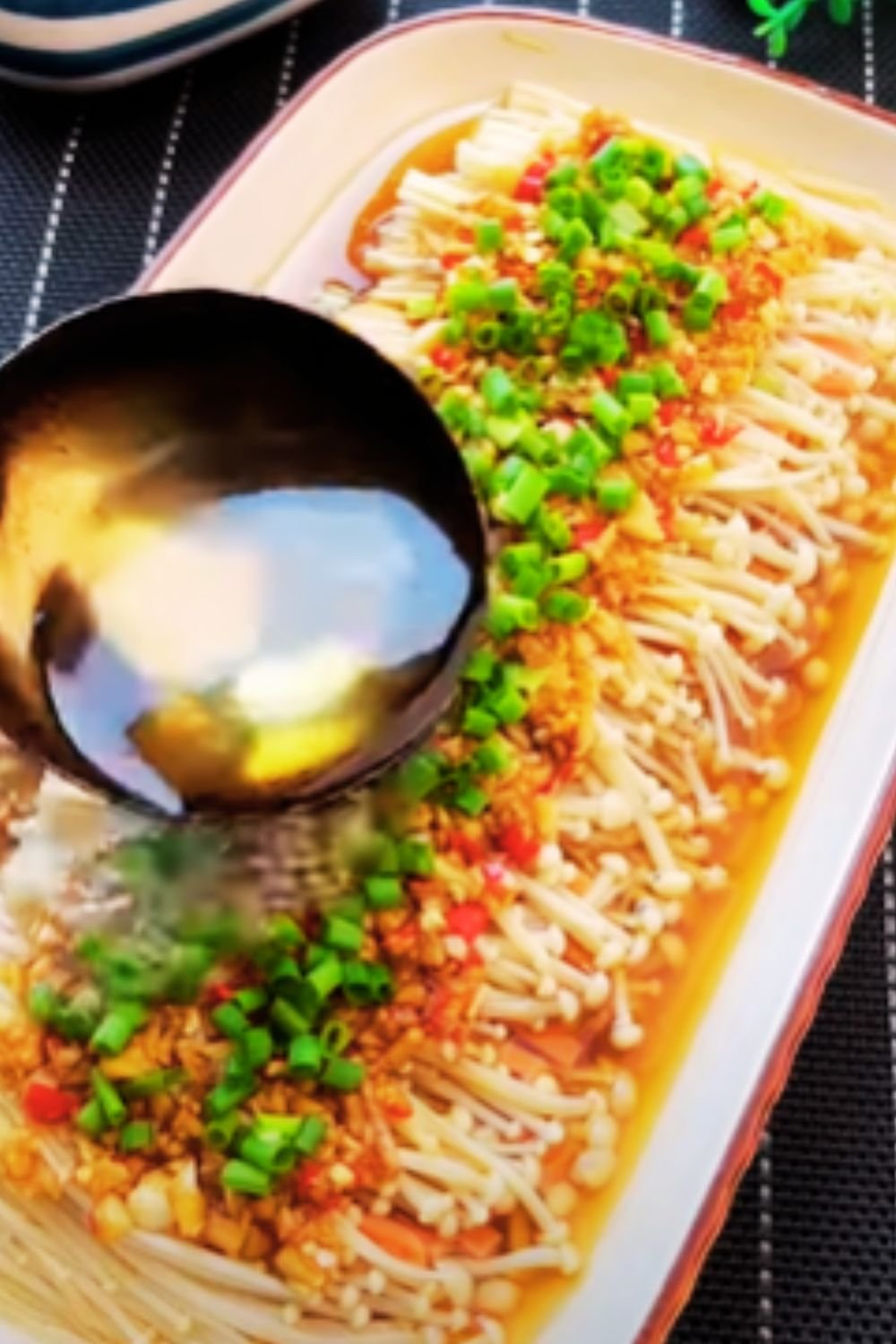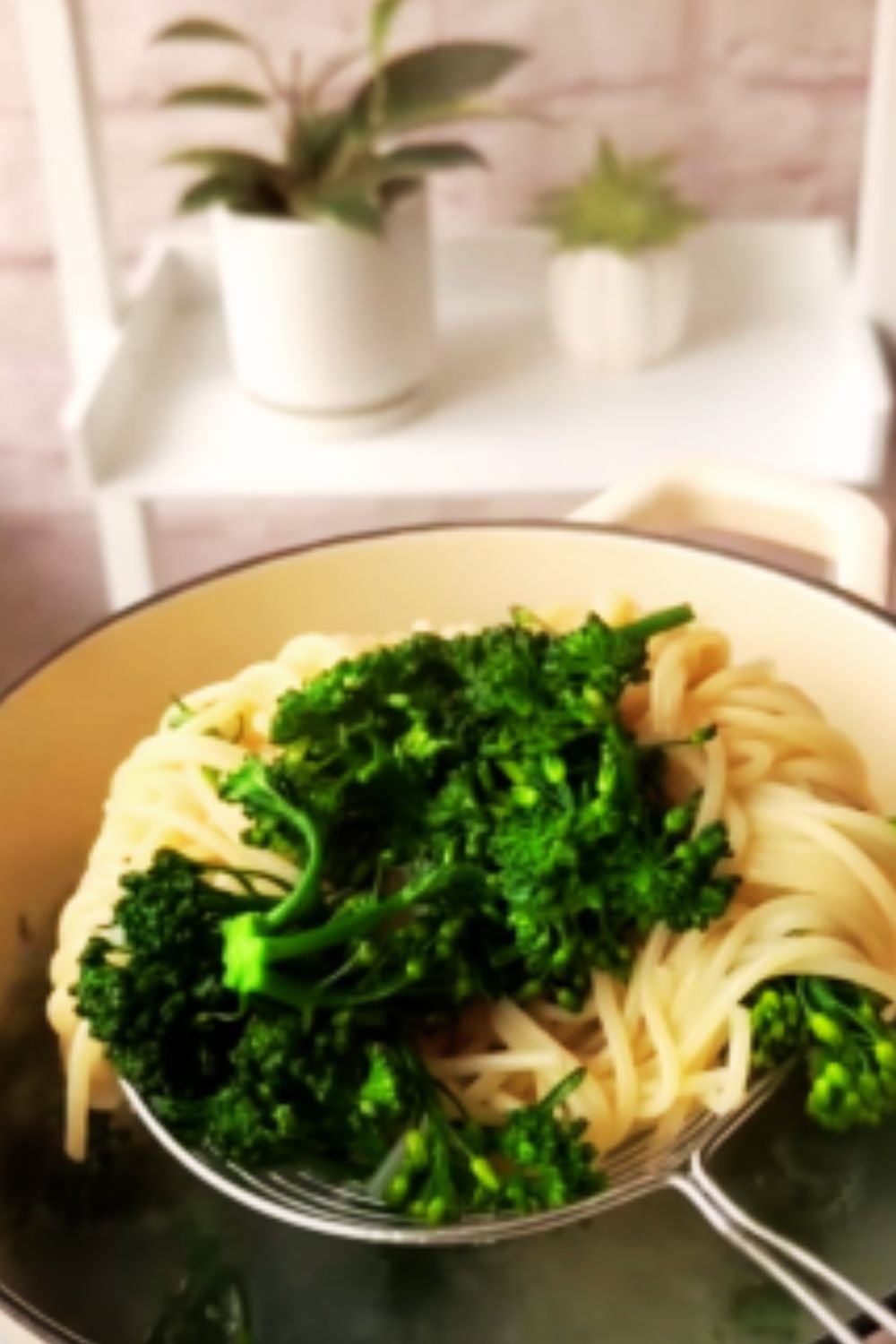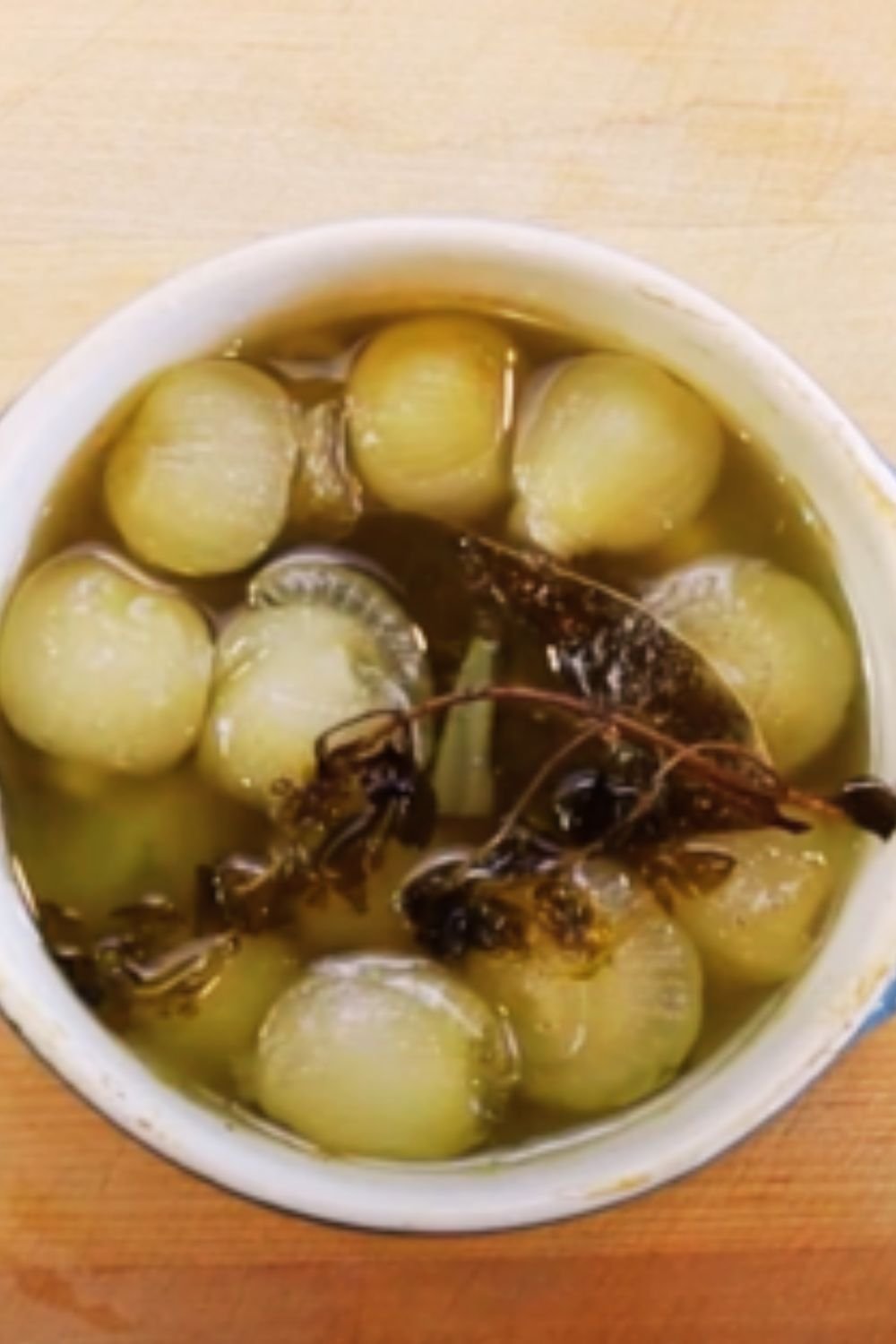There’s something magical about the delicate nature of enoki mushrooms that has captivated my culinary imagination for years. These slender, white mushrooms might seem unassuming at first glance, but they pack a remarkable umami punch when prepared with the right companions. Today, I’m sharing one of my favorite ways to highlight these distinctive fungi: Enoki Mushrooms with Garlic & Scallion Sauce.
As someone who’s experimented with countless mushroom varieties in my kitchen, I can confidently say that enoki mushrooms deserve more attention in home cooking. Their unique texture—slightly crunchy yet tender—makes them perfect for quick cooking methods, while their mild flavor serves as an excellent canvas for bolder ingredients like garlic and scallions.
This recipe transforms humble enoki mushrooms into an elegant dish that works beautifully as an appetizer, side dish, or even a light main when served over rice. The sauce, with its perfect balance of savory, slightly spicy, and aromatic notes, elevates the mushrooms while still allowing their natural essence to shine through.
What Are Enoki Mushrooms?
Before diving into the recipe, let’s take a moment to appreciate these fascinating fungi. Enoki mushrooms (Flammulina velutipes), also known as golden needle mushrooms or lily mushrooms, are native to East Asia but are now cultivated worldwide.
These mushrooms grow in clusters with long, slender stems and small caps. Wild enoki mushrooms are typically darker in color, while cultivated varieties—the ones most commonly found in stores—are white due to being grown in dark environments.
Nutritional Profile
Enoki mushrooms aren’t just delicious; they’re nutritional powerhouses too. Here’s what makes them so special:
| Nutrient | Amount per 100g | Health Benefits |
|---|---|---|
| Calories | 37 | Low in calories, making them ideal for weight-conscious diets |
| Protein | 2.4g | Plant-based protein source |
| Fiber | 2.7g | Supports digestive health |
| Niacin | 5.6mg (35% DV) | Helps convert food to energy |
| Riboflavin | 0.2mg (15% DV) | Supports cellular function and energy production |
| Thiamine | 0.2mg (15% DV) | Essential for nerve and muscle function |
| Potassium | 400mg (11% DV) | Regulates fluid balance and muscle contractions |
| Selenium | 2.4μg | Important antioxidant protecting cells from damage |
| Beta-glucans | Variable | Immune system support |
DV = Daily Value based on a 2,000-calorie diet
Research suggests that enoki mushrooms may have various health benefits, including immune system support, anti-inflammatory properties, and potential anti-cancer effects due to their bioactive compounds. They’re also cholesterol-free and low in sodium, making them heart-friendly.
Ingredients for Enoki Mushrooms with Garlic & Scallion Sauce

For 4 servings as an appetizer:
For the Mushrooms:
- 400g (14 oz) fresh enoki mushrooms
- 1 tablespoon neutral oil (such as grapeseed or canola)
- Pinch of salt
For the Garlic & Scallion Sauce:
- 4 cloves garlic, minced
- 4 scallions (green onions), white parts minced, green parts thinly sliced
- 2 tablespoons neutral oil
- 3 tablespoons low-sodium soy sauce (or tamari for gluten-free option)
- 1 tablespoon rice vinegar
- 1 teaspoon sesame oil
- 1 teaspoon honey or maple syrup
- 1 teaspoon grated fresh ginger
- ½ teaspoon chili flakes (adjust to taste)
- 1 tablespoon toasted sesame seeds
For Garnish:
- Additional thinly sliced scallion greens
- Extra toasted sesame seeds
- Microgreens or cilantro leaves (optional)
Equipment Needed
- Sharp knife and cutting board
- Large non-stick skillet or wok
- Small saucepan
- Small mixing bowl
- Measuring spoons
- Kitchen tongs or cooking chopsticks
- Serving platter
Preparation Method
Step 1: Prepare the Enoki Mushrooms
- Trim off the base of the enoki mushrooms (approximately the bottom inch where they’re connected).
- Gently separate the mushrooms into smaller bundles, being careful not to break them.
- Rinse the mushrooms very briefly under cold water and pat them completely dry with paper towels or a clean kitchen towel. Tip: Excessive moisture will prevent proper browning, so ensure they’re thoroughly dried.
Step 2: Make the Garlic & Scallion Sauce
- In a small saucepan, heat 2 tablespoons of neutral oil over medium-low heat.
- Add the minced garlic and white parts of the scallions to the oil, stirring frequently to prevent burning.
- Cook for 2-3 minutes until fragrant and just beginning to turn golden.
- Transfer the garlic-scallion mixture to a small bowl.
- Add the soy sauce, rice vinegar, sesame oil, honey or maple syrup, grated ginger, and chili flakes to the bowl.
- Stir well to combine, then mix in the toasted sesame seeds and the green parts of the scallions (reserving some for garnish).
- Let the sauce sit for at least 10 minutes to allow the flavors to meld.
Step 3: Cook the Enoki Mushrooms
- Heat a large non-stick skillet or wok over medium-high heat.
- Add 1 tablespoon of neutral oil and swirl to coat the pan.
- Once the oil is hot but not smoking, carefully add the enoki mushrooms in a single layer, working in batches if necessary.
- Allow the mushrooms to cook undisturbed for 1-2 minutes until the bottom side begins to brown.
- Using tongs or cooking chopsticks, gently turn the mushrooms and cook for another 1-2 minutes.
- Season with a small pinch of salt.
- The mushrooms are done when they’re lightly golden and slightly tender but still maintain some crunch.
- Transfer the cooked mushrooms to a paper towel to drain any excess oil.
Step 4: Serve
- Arrange the cooked enoki mushrooms on a serving platter.
- Drizzle the garlic and scallion sauce generously over the mushrooms.
- Garnish with the reserved scallion greens, additional sesame seeds, and microgreens or cilantro if using.
- Serve immediately while hot.
Cooking Tips & Variations

Perfect Enoki Every Time
- Don’t Overcook: Enoki mushrooms cook quickly and should retain some crispness. Overcooking makes them limp and diminishes their pleasant texture.
- Control Moisture: Excess moisture is the enemy of proper browning. Make sure your mushrooms are thoroughly dried after washing.
- High Heat is Key: A hot pan ensures quick cooking and proper caramelization without steaming the mushrooms.
- Space is Important: Don’t overcrowd the pan—cook in batches if necessary to ensure even browning.
Creative Variations
- Spicy Version: Double the chili flakes and add a teaspoon of gochujang (Korean chili paste) to the sauce for extra heat.
- Citrus Twist: Add 1 teaspoon of orange zest and 1 tablespoon of fresh orange juice to the sauce for a bright, citrusy note.
- Herb Enhancement: Mix in 1 tablespoon of finely chopped fresh herbs such as cilantro, mint, or Thai basil just before serving.
- Nutty Addition: Include 2 tablespoons of crushed peanuts or cashews for added texture and nutty flavor.
- Coconut Infusion: Replace the soy sauce with coconut aminos and add 2 tablespoons of coconut cream to the sauce for a tropical twist.
Serving Suggestions
This versatile dish pairs wonderfully with various meals:
- As an appetizer alongside other small plates in an Asian-inspired feast
- As a side dish with grilled fish or tofu
- Atop a bowl of steamed jasmine rice for a light main course
- Inside Vietnamese summer rolls with fresh herbs
- Alongside a bowl of miso soup for a light lunch
- As a topping for avocado toast for a savory breakfast option
- Mixed into a grain bowl with quinoa, edamame, and pickled vegetables
- As a garnish for ramen or udon noodle soup
Storage and Reheating
While this dish is best enjoyed fresh, you can store leftovers in an airtight container in the refrigerator for up to 2 days. I recommend storing the mushrooms and sauce separately if possible.
To reheat, warm the mushrooms gently in a dry skillet over medium-low heat until just warmed through (about 1-2 minutes), then drizzle with the sauce. Alternatively, you can enjoy this dish cold as part of a salad or grain bowl.
Sourcing Quality Enoki Mushrooms

When shopping for enoki mushrooms, look for:
- Firm, white stems with small, unblemished caps
- Crisp texture that snaps when bent
- No sliminess, dark spots, or strong odor
- Clean base area where the cluster connects
You can typically find enoki mushrooms at:
- Asian grocery stores in the refrigerated produce section
- Farmers’ markets, especially those with specialty mushroom vendors
- Some mainstream supermarkets with expanded produce sections
- Online specialty food retailers that ship fresh
If you can’t find fresh enoki mushrooms, dried versions are sometimes available. To use dried enoki, soak them in warm water for 20-30 minutes until fully rehydrated, then drain thoroughly before cooking. Keep in mind that rehydrated mushrooms will have a slightly different texture than fresh ones.
Health Considerations
This dish is naturally:
- Low in calories
- Rich in vitamins and minerals
- Vegan-friendly (when using maple syrup instead of honey)
- Gluten-free (when using tamari instead of soy sauce)
For those monitoring sodium intake, you can reduce the amount of soy sauce and add a squeeze of fresh lemon juice for flavor enhancement.
The Cultural Significance of Enoki Mushrooms
In Japanese cuisine, enoki mushrooms (えのき茸, enokitake) are commonly used in hot pots, soups, and stir-fries. They’re particularly popular in winter dishes for their warming qualities according to traditional food philosophy.
In Korean cooking, enoki mushrooms (팽이버섯, paengi beoseot) often appear in bulgogi, stews, and as banchan (side dishes).
Chinese cuisine incorporates golden needle mushrooms (金针菇, jīn zhēn gū) in hot pots, stir-fries, and steamed dishes, prizing them for both flavor and medicinal properties in traditional Chinese medicine.
Across East Asian cultures, these mushrooms are valued not just for their culinary applications but also for their health benefits, which have been recognized for centuries in traditional medicine practices.
Frequently Asked Questions
Q: Can I use other mushroom varieties if I can’t find enoki?
While enoki mushrooms have a unique texture and mild flavor that works perfectly in this recipe, you could substitute with thinly sliced king oyster mushrooms or shimeji mushrooms. The cooking time may need adjustment depending on the variety you choose.
Q: Is there a substitute for rice vinegar?
Yes, you can use apple cider vinegar or white wine vinegar with a pinch of sugar as a substitute. The flavor profile will be slightly different but still delicious.
Q: How do I know when enoki mushrooms have gone bad?
Fresh enoki mushrooms should be firm, white, and odorless. If they develop a slimy texture, dark spots, or a strong smell, they’ve gone bad and should be discarded.
Q: Can this dish be made ahead for a party?
The sauce can be made up to 24 hours in advance and stored in the refrigerator. However, I recommend cooking the mushrooms just before serving for the best texture and flavor.
Q: Are enoki mushrooms safe to eat raw?
While technically edible raw, enoki mushrooms are more digestible and flavorful when cooked. The cooking process also helps eliminate any potential bacteria.
Q: How can I make this dish less salty?
Use low-sodium soy sauce and reduce the amount to 2 tablespoons. You can also balance the saltiness with a bit more honey or maple syrup, or add a squeeze of fresh lemon juice.
Q: Can I freeze leftover cooked enoki mushrooms?
I don’t recommend freezing this dish as the mushrooms will lose their delicate texture upon thawing. It’s best enjoyed fresh or within 2 days when refrigerated.
Q: What’s the difference between white and brown enoki mushrooms?
White enoki mushrooms are cultivated in dark environments, preventing them from developing color. Brown (or wild) enoki mushrooms grow naturally with exposure to light. Brown enoki have a stronger flavor, while white ones are milder and more commonly available.
Conclusion
Enoki mushrooms with garlic and scallion sauce is a beautiful example of how simplicity often yields the most impressive results. The delicate mushrooms paired with a vibrant, aromatic sauce create a harmonious dish that balances textures and flavors masterfully.
What I love most about this recipe is its versatility—it can elevate a simple weeknight dinner or hold its own as part of an elaborate spread for guests. Plus, it introduces many home cooks to a mushroom variety they might not regularly use, expanding their culinary horizons.
I encourage you to experiment with the basic formula. Once you’re comfortable with the technique, try incorporating your own favorite flavors or adapting it to what’s seasonally available. Cooking is about exploration and finding what delights your personal palate.
Whether you’re a mushroom enthusiast or just beginning to explore the fascinating world of fungi, this enoki mushroom dish promises to deliver a memorable eating experience that celebrates the subtle complexity of one of nature’s most interesting ingredients.


